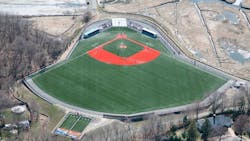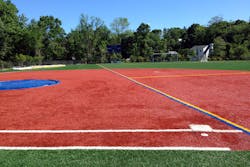Turf Time for a Seamless Experience
As municipalities, schools, colleges and universities look for cost-effective and sustainable solutions for their athletic facilities, many have looked to synthetic turf for playing fields. Compared with natural grass, synthetic turf offers enhanced design options, is less expensive on a cost-per-use basis, provides additional environmental benefits, and can be easier to maintain.
Also, research indicates that synthetic turf is a safe playing surface for all ages.
The thin green carpeted fields over a hard base are mostly a thing of the past. Modern synthetic turf fields are made of longer fibers that look like natural grass and have a “crumb” rubber or sand infill that creates a responsive and comfortable playing surface.
Installation methods differ, depending on the product. Generally, a porous backing, leveling layer, stone layer, and drainage system are installed beneath the playing surface. Often, an additional pad is installed under the backing layer to provide extra shock absorption.
The drainage system also may include a screening or detention system that meets environmental and regulatory requirements for stormwater management. A properly installed turf field is tested for water-percolation rates, shock-absorption properties, and other safety and product integrity benchmarks.
Lower Cost-Per-Play
A common misconception is that high-quality synthetic turf is affordable only with a professional team budget. The initial cost of a synthetic turf field may be higher than a natural grass installation; however, on a cost-per-play basis, synthetic turf is less expensive. The costs can be as much as 70 or 80 percent less than natural grass fields, according to a University of California-Berkeley study.
The primary factor in cost savings is increased playing time. Synthetic turf fields can be played on during or after wet weather, unlike natural grass, which can be torn up when saturated. In addition, synthetic turf fields most often are designed for multi-sport use. A baseball or softball outfield could overlap with space designed for soccer, football, field hockey, and more. A design firm and installation contractor can assist with the optimal layout to accommodate field markings and appropriate spacing.
Natural grass requires downtime for mowing, irrigation and periods of rest to reduce compaction. Synthetic turf needs far less attention and downtime. Once the infill settles a few months after installation, basic maintenance includes occasional brushing and raking to straighten matted fibers and keep the infill evenly distributed and loose.
Chemical spills and body fluids should be scrubbed with a manufacturer-approved cleaning product. Weeds and moss might grow on perimeter areas that get less traffic. These should be removed carefully without tearing or damaging the surface. The most important maintenance measure is signage and education to prohibit gum chewing, tobacco use and food consumption. Repairs are needed from time to time, and coaches and staff should keep an eye out for any trouble spots. Most turf products are covered by a warranty.
Improved Player Safety
Often, natural grass fields are not well-maintained or are poorly designed. Many institutions do not have the resources to provide the required upkeep. Insufficient drainage and overuse leads to over-compacted soils—producing uneven or hard sections with poor vegetation. Uneven fields can lead to foot and leg injuries.
Careful attention to the subsurface design and construction of a synthetic turf field provides a level and consistent playing surface and minimizes long-term settling. A 2004 NCAA study of injuries found that the injury rate during practice sessions was 4.4 percent on natural grass and 3.5 percent on synthetic turf. In 2010, a peer-reviewed study published in the American Journal of Sports Medicine on injuries during college football games found a significant difference in injury rates on a high-quality brand of synthetic turf compared with natural grass: 12 percent fewer concussions and 32 percent fewer ligament tears occurred on synthetic turf.
Head trauma and the long-term effects of repeated head impact are of utmost concern to athletes and their families. Scientists are just beginning to understand the short- and long-term risk of collisions and concussions sustained in athletics—particularly in youth and collegiate sports.
The role of the playing surface in minimizing the force of impact and improving player safety should not be overlooked. An athletic field’s impact-absorbing properties are assessed by a standard measure of ASTM International, formerly known as the American Society for Testing and Material. This standard method measures the acceleration of a test object bouncing off a playing surface. The resulting value, the G-Max rating, is one quantitative safety indicator. A higher G-max rating means the playing surface is too hard and an athlete’s body will absorb too much of the force of impact, which makes the player more vulnerable to injuries.
Synthetic turf fields are designed to meet or exceed the G-Max rating of the best natural grass playing surfaces. A professional-level, appropriately maintained natural grass field could have a G-max of about 70 g’s. For reference, the g-force of a fighter jet roll is about 9 g’s. More commonly, a natural grass field with typical maintenance will have an average G-max of 90 to 100 g’s.
With the inclusion of a well-designed field cross-section, the G-max level of a synthetic turf field is held in the range of 70 to 100 g’s, similar to that of the best natural grass fields. Field testing should be conducted when a new athletic field (both natural and synthetic) is installed and in subsequent years to measure any degraded or overly compacted areas.
As noted, a synthetic turf installation may include a specifically designed subsurface shock pad for a safer, more consistent playing surface. The shock pad reduces and maintains the overall G-max at an acceptable level, typically for the life of the turf. Players and coaches occasionally voice worries about a synthetic field being unresponsive or slow. A too-soft field or a minimum G-max level is not a concern if the turf system is designed correctly.
One benefit that natural grass has compared with synthetic turf is its cooler surface temperature. Studies show that surface temperatures on synthetic turf fields are higher in the same environment. This makes athletes more susceptible to heat stress. Penn State University experimented with several methods to reduce synthetic turf temperatures (irrigation, covering the field, and changing infill material), but none proved to be long-lasting. Schools should consider using misting fans, installing cover for shade near the field, and providing education on heat stress symptoms and hydration to mitigate heat stress issues.
Also, the California Office of Environmental Health Hazard Assessment (OEHHA) study found that skin abrasions or “turf burns” occur more frequently on synthetic turf. However, the perception that players are at higher risk to infection is not true. The OEHHA stated: “Fewer bacteria were detected on artificial turf compared [with] natural grass. This was true for MRSA and other Staphylococci capable of infecting humans.”
Green considerations
Synthetic turf doesn’t require watering, pesticides or herbicides. The infill is mostly recycled rubber, and the surface can be recycled at the end of its use. It doesn’t require mowing, which reduces fuel costs and carbon emissions.
Many institutions have chosen synthetic turf to replace aging or damaged playing fields, and others are using it to transform environmentally challenged sites. Rehabilitation and adaptive reuse projects require ecological testing and remediation measures, such as a soil cap or groundwater treatment, but it is possible to successfully use a brownfield for an athletic field or facility development.
Many state, university and private entities have researched and addressed potential negative health effects from volatile organic compounds (VOCs) and fine particles through ingesting, inhaling or skin exposure to synthetic turf and infill, and no public health concerns have been identified.
Some tests in New York and New Jersey found elevated lead levels on older synthetic turf fields, which prompted a health advisory from the Centers for Disease Control and Prevention. Subsequent studies, including the California OEHHA report, found lead and other heavy metals either below detection or at levels under the EPA standard for bare soil. The OEHHA stated that the composition of lead at the test sites suggests that the cause is something other than the synthetic turf, like an upwind source. Still, it is possible to select synthetic turf products that do not have detectable lead levels before installation.
Kennedy is director of athletics at Mercy College, Dobbs Ferry, N.Y. Catalano, PE, BCEE, is senior vice president and civil and environmental engineer at Woodard & Curran, an integrated engineering, science and operations company. He is a leader of the firm’s athletic field and recreation facility design and engineering services in White Plains, N.Y. Shay, PE, is a project engineer at Woodard & Curran.

